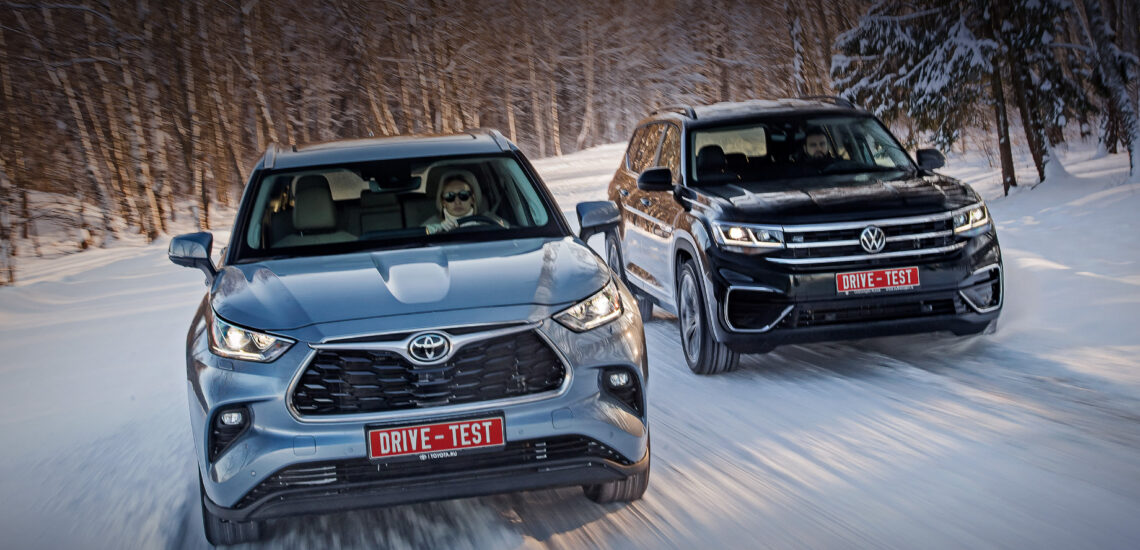Le Highlander est le plus cher de sa catégorie. Il se vend à partir de 55 000 dollars, mais ses adversaires sont moins chers de 4 à 11 000 dollars. Pas de problème ! Au cours de la dernière année difficile, Toyota a vendu 264 128 Highlander. L’amour de la marque a-t-il doublé le volume des ventes, ou est-ce autre chose ? Nous le découvrirons en compagnie du Volkswagen Teramont à sept places et à transmission intégrale. Au cours de l’année écoulée, 162 437 voitures de ce modèle ont trouvé preneur.
La qualité de construction du Highlander n’est certainement pas un point d’orgueil de l’usine américaine de Princeton. Les écarts sont importants entre presque tous les panneaux de carrosserie. Les joints de la porte du coffre, des ailes arrière et du pare-chocs attirent l’attention. Et l’on peut facilement passer la moitié de son index entre le capot et le phare à LED. S’agit-il d’une Toyota ? Oui. Il suffit de regarder cette apparence gonflée.
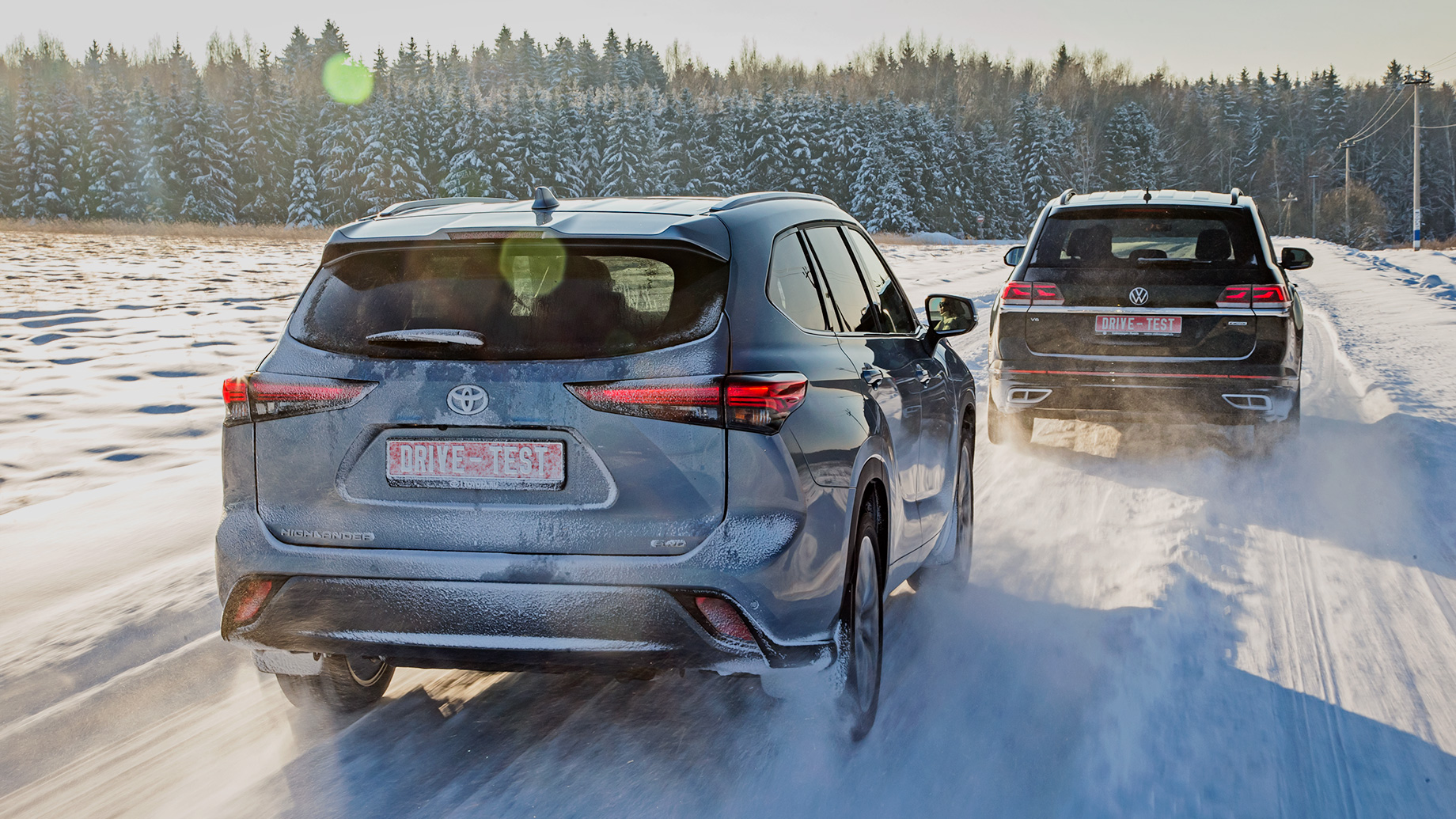
Le Teramont est mieux assemblé. L’impression est différente. La carrosserie anguleuse avec des inclusions chromées semble avoir été taillée dans un morceau de marbre noir. La brutalité est donnée par les éléments du pack R-Line Sports : un pare-chocs avant avec des prises d’air élargies, un pseudo diffuseur et de larges jantes de 21 pouces (la Toyota en a de 20 pouces). En revanche, le groupe de quatre embouts d’échappement s’avère être un accessoire bon marché : un entourage chromé sans trous est posé le long du pare-chocs.
Les ouvertures des portes avant des deux crossovers sont également dégagées. Les bas de caisse sont toujours propres car ils sont fermés hermétiquement par les portes. Les types d’aménagement sont légèrement différents. En essayant de maintenir un équilibre entre le style urbain et le style « capitaine », les Japonais se sont finalement concentrés un peu plus sur le second. En outre, le volant du Highlander est installé plus délicatement, de sorte que vous êtes assis un peu plus près de lui et que vos jambes sont encore plus pliées.
Un siège doté d’un rembourrage doux et de coussins latéraux souples et bien espacés vous détend. Les finitions sont également agréables : plastique de bonne qualité, cuir sur les panneaux de porte, coutures avec de vrais fils… On dit que 50 000 dollars n’ont pas été dépensés en vain. L’intérieur généralement confortable n’est gâché que par une piètre imitation de bois et une multitude de boutons bon marché qui auraient dû être abandonnés il y a longtemps…
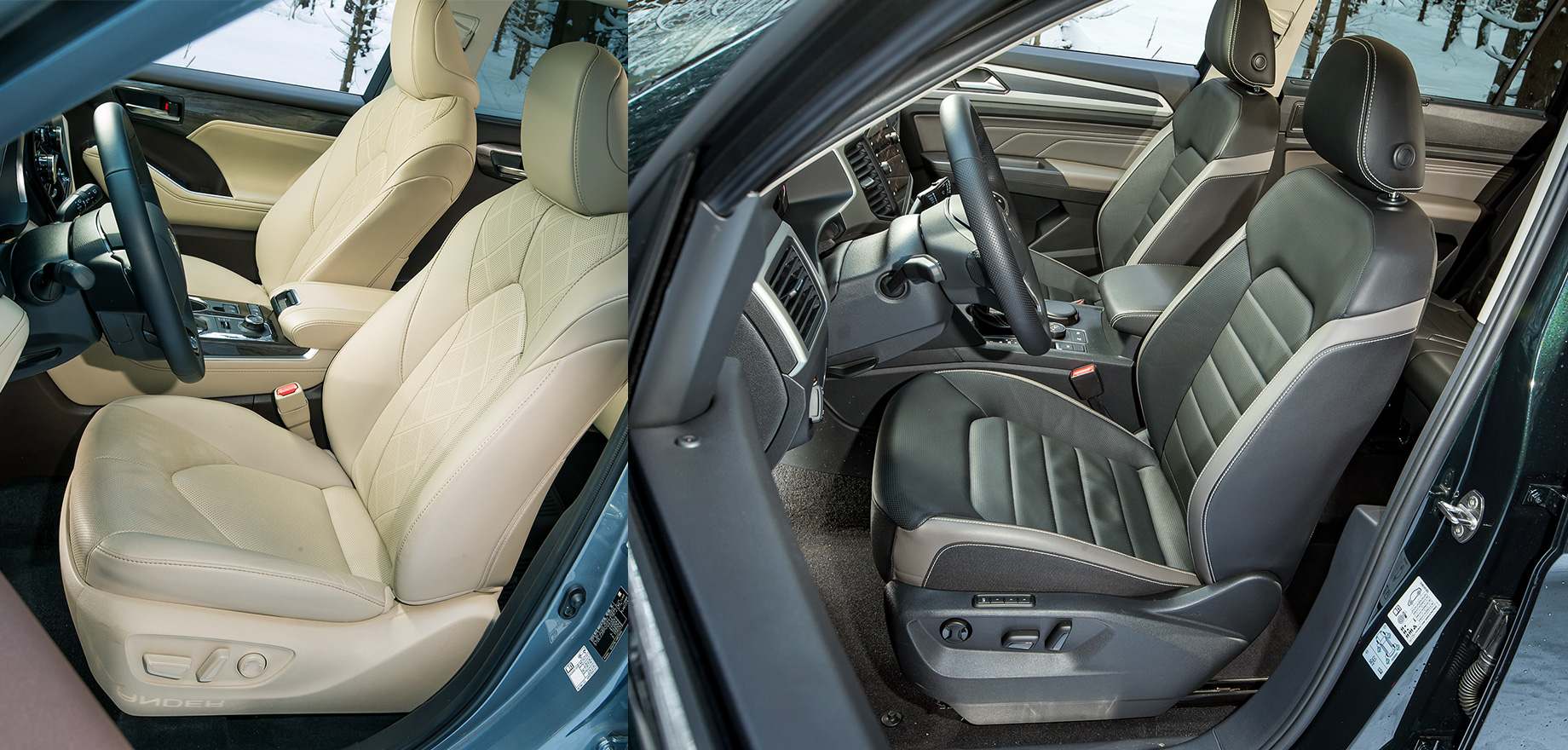
La Toyota n’a pas de problèmes d’ergonomie, mais il y a suffisamment de petits défauts. Nous aimerions que le bouton de chauffage du volant soit placé sur l’unité de commande de la climatisation, et non à gauche du haut-parleur entouré des touches de commande des caméras panoramiques et de l’actionnement électrique du coffre. L’écran central ne répond pas immédiatement à la pression, se fige lors du swiping et est situé un peu loin du conducteur.
Avec ses matériaux de finition, le Teramont est proche de la Polo économique, l’espace libre sur la rangée avant ressemble au Multivan, et l’ergonomie est similaire à toutes les Volkswagen à la fois. Il n’y a qu’une petite revendication au niveau du levier de vitesse, qui passe indistinctement du mode D au mode S. Il ne dispose pas du multimédia le plus moderne, et la résolution de l’écran laisse à désirer, mais cet infocomplexe fera facilement le poids face à l’archaïque de Toyota. En revanche, les deux systèmes pourraient établir plus rapidement une communication avec les smartphones.
La Volkswagen maintient le conducteur debout. Le siège avec un rembourrage dense et de puissantes excroissances de soutien latéral fixe parfaitement le corps, et le volant sportif avec de fines branches est placé plus verticalement. L’humeur combative est également soutenue par la géométrie de l’atterrissage : le siège est plus bas et les jambes sont plus fortement tendues. En même temps, il ne faut pas oublier que l’on est toujours assis dans un crossover.
Le Teramont est plus long que le Highlander, la distance entre les essieux est plus importante. Les ouvertures des portes sont si impressionnantes qu’il est possible d’entrer à deux dans le véhicule. L’espace sur la banquette arrière est king-size : derrière le siège du conducteur ajusté à ma taille de 5’09, je m’assois avec un espace de 5,91 pouces devant mes genoux, et un autre de 5,51 pouces reste au-dessus de ma tête. Le Highlander me laisse 4,33 pouces aux pieds et 1,57 pouce au plafond.
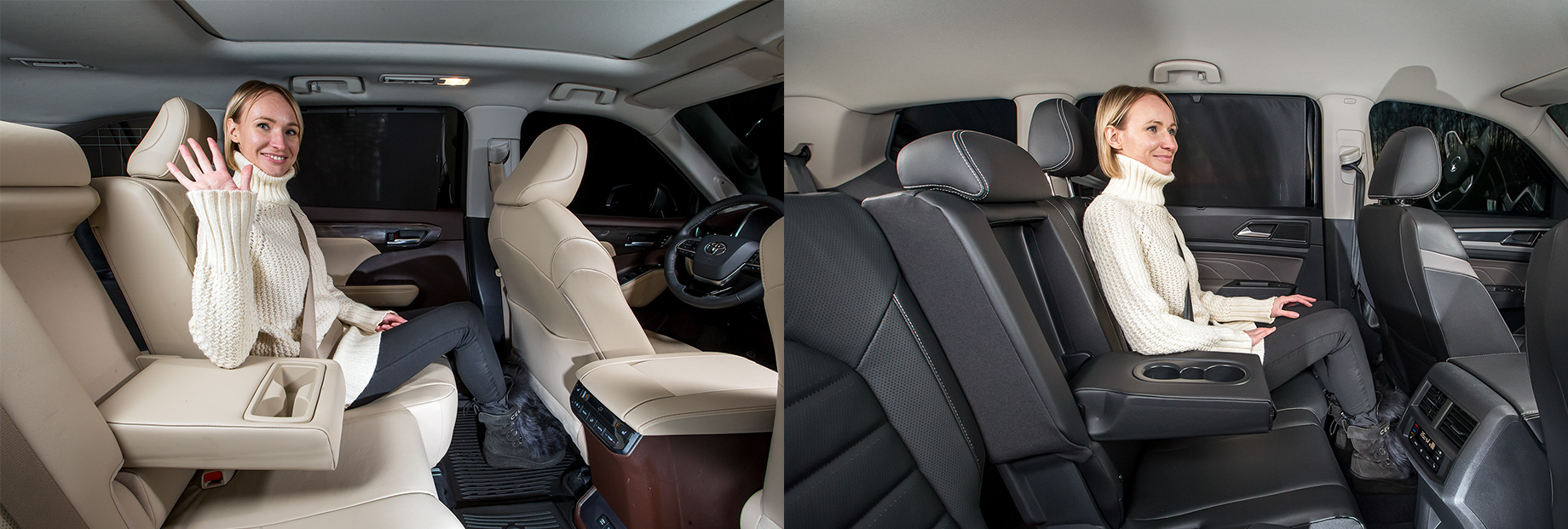
Sur la deuxième rangée de la Volkswagen, il est plus pratique de s’asseoir à trois – il y a plus d’espace libre en largeur et pour les jambes d’un passager moyen. L’amplitude des mouvements longitudinaux de la banquette arrière est plus impressionnante, et le réglage de l’angle du dossier permet de s’asseoir en position inclinée. Il y a les avantages de la civilisation : une unité de contrôle climatique séparée, des sièges chauffants, une paire de connecteurs USB et des rideaux sur les fenêtres.
Cependant, le Highlander possède également tous ces avantages, y compris le dossier de la deuxième rangée qui s’incline à un grand angle. La Toyota est certes plus proche, mais sur un long trajet en tant que passager, je m’en remettrais à elle. Un siège confortable dans un revêtement en cuir délicat sur un rembourrage doux attire. C’est exactement ce qui manque au Teramont, dont la rigidité de la banquette arrière est comparable à celle des sièges avant.
Mais je ne voudrais pas me retrouver dans la troisième rangée de la Toyota, même dans le cadre d’un court voyage. S’il est encore possible de libérer de l’espace devant les genoux en faisant coulisser le siège de la deuxième rangée, la tête repose de toute façon contre le plafond. En même temps, vous êtes assis bas, avec des jambes excessivement serrées. La rangée arrière du Teramont est plus favorable : il est plus facile d’y accéder, la réserve d’espace est préservée dans toutes les directions et il est plus pratique de s’asseoir sur des sièges moins plats.
Pendant que nous sautons d’une rangée à l’autre, les moteurs atmosphériques ont le temps de s’échauffer. Ils bruissent tranquillement, sans vibrer. Les deux moteurs six cylindres en V développent 249 ch chacun, avec un avantage de couple minime en faveur de la Volkswagen de 360 N-m contre 356 pour la Toyota. A l’ère de la suralimentation, ces moteurs ne sont pas impressionnants, mais les tâches qui leur sont assignées sont bien remplies. Ils réagissent vivement à l’alimentation en carburant, tirent solidement à partir de 2500 tr/min jusqu’à la zone très rouge, et n’abandonnent pas sur les routes de campagne dans le respect du code de la route.
Le Toyota atteint son maximum de puissance et de traction à des régimes plus élevés, et il pèse presque autant que le Teramont, mais les démarrages parallèles révèlent sa totale supériorité. La différence est surtout perceptible lors des accélérations à partir de l’arrêt, lorsque le Highlander prend de l’avance avec puissance dans les deux premières secondes et creuse lentement l’écart jusqu’à 80,8 miles par heure. La capacité d’accélération est un peu plus modeste en mouvement, mais que dire de l’accélération de 37,29 mile/h à 62,15 mile/h, que de 49,72 mile/h à 74,58 mile/h Toyota laisse certainement Volkswagen. Teramont reste à saisir la peine – sa consommation de carburant dans des conditions similaires est de 2-3,5 l/62,14 mile plus.
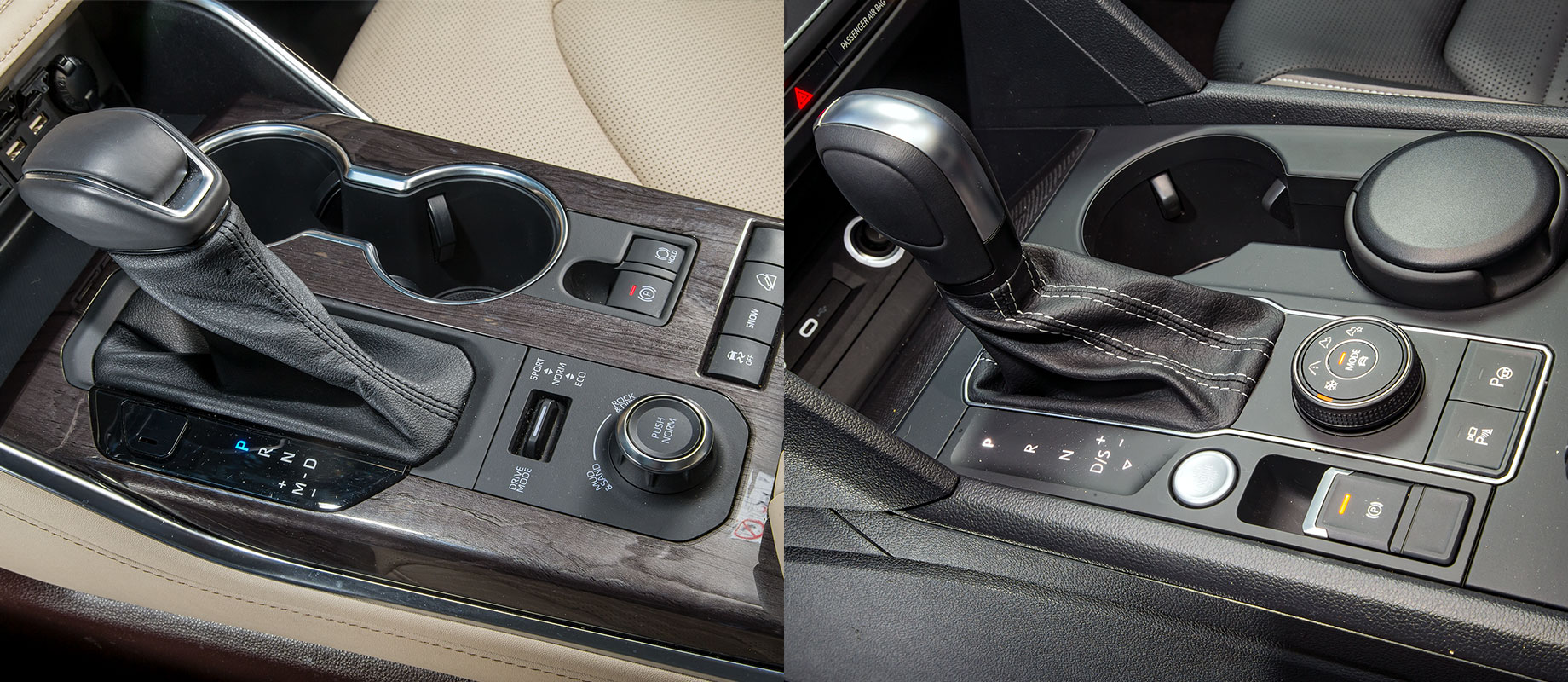
Les deux voitures sont équipées d’une boîte de vitesses AGB Aisin AWF8F45 à huit rapports. Elle est bien réglée dans les deux cas. Même en réponse à une légère pression sur l’accélérateur, elle rétrograde rapidement d’un rapport, et si vous la poussez correctement, elle passe sans trop de retard, par exemple, de la huitième à la quatrième. Par conséquent, dans la Toyota, on ne se souvient même pas de l’absence d’un mode sport séparé, et dans la Volkswagen, on l’utilise rarement. La possibilité de prolonger l’autonomie n’est pas superflue.
Par exemple, lorsque vous conduisez rapidement sur une route sinueuse. Pour une grande voiture, c’est une situation plutôt atypique, mais la Volkswagen de cinq mètres la supporte. Une réactivité assez naturelle au volant se combine avec des embardées modérées et une bonne ténacité dans les arcs de cercle à grande vitesse. Sur la neige, le Teramont avec le Haldex V reste dans les mémoires pour une glisse prévisible et excitante. Le réglage de la pédale de frein est un peu en retrait, dont la course pourrait être plus courte. L’efficacité mécanique n’est pas en cause.
Les gourous de la suspension ont fait du Teramont presque le plus audacieux de la catégorie et… sont rentrés à la maison. À en juger par les secousses, ils ne se sont jamais revus. Même les irrégularités moyennes réagissent par de fortes accélérations verticales, et sur les gros nids-de-poule, l’« Allemand » tremble de toute sa carrosserie de deux tonnes. La carrosserie oscille inconfortablement d’un côté à l’autre, ce qui fatigue beaucoup les passagers, et les vibrations des roues divergent sur le plancher. Seules les petites ondulations de la route n’ont pas d’effet sur la Volkswagen.
Le Highlander n’est pas aussi réactif et précis dans ses réactions, un effort non naturel sur le volant éloigne la voiture du conducteur – et cet état de fait est corrigé à coup sûr par un système de stabilisation strict et non commutable. Le réglage de la transmission intégrale est fastidieux, et la force exercée sur la pédale de frein est trop importante. Par conséquent, la sensation de faible efficacité de la décélération ne disparaît pas, même en mode de conduite normal.
En revanche, le confort de conduite est nettement meilleur sur toutes les bosses. La route parsemée de fosses est particulièrement révélatrice : le Highlander y semble moins mou et moins chargé en vibrations par les masses non suspendues. Bien qu’un coup de pied serré lors de la traversée de joints indique qu’il est préférable de choisir des roues de 18 pouces lors de l’achat d’une Toyota.
Le Highlander tient mieux la route sur une piste cahoteuse. Il s’élance sans inquiétude et sans rupture, faisant preuve d’une intensité énergétique et d’une douceur inaccessibles au Teramont. Il suffit de surveiller les mouvements de la carrosserie pour ne pas heurter de plein fouet une motorisation dépourvue de protection métallique à part entière.
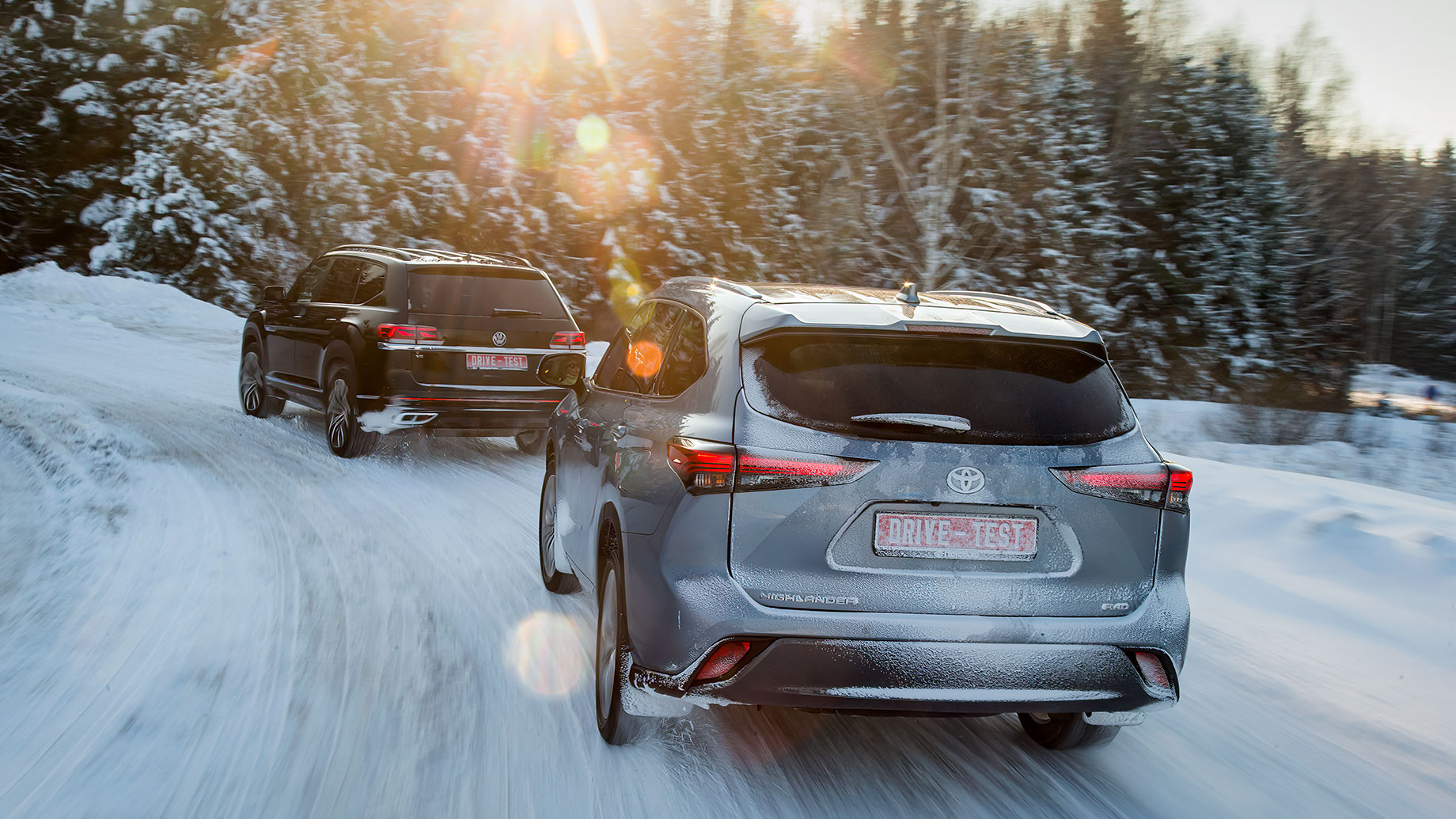
La Volkswagen l’a. En outre, il possède la meilleure capacité de franchissement géométrique et un meilleur réglage de l’assistance tout-terrain. Au volant du Teramont, il n’est pas nécessaire d’activer le mode tout-terrain pour gérer le franchissement. Le Toyota, sans le soutien du mode tout-terrain, fait tourner les roues libres de manière impuissante.
En tant que voiture familiale, le Highlander est plus compact que le Teramont. Il ne se dissout pas dans un comportement intéressant, mais offre un meilleur confort de conduite, ce qui est beaucoup plus significatif dans le segment. La Toyota a un intérieur plus confortable, elle est plus dynamique et consomme moins d’essence, qui peut être AI-92, alors que le Teramont a besoin d’AI-95. Cependant, tout l’argent économisé sur le carburant sera dissous dans le surpaiement de la Toyota. Pas sûr que cela en vaille la peine.
Le Teramont testé n’est pas non plus à la hauteur de l’achat d’un siècle. Il est glouton, le châssis n’est pas équilibré. Mais si vous sacrifiez le V6 à la mode au profit d’un « quatre » suralimenté pratique, le crossover deviendra plus rapide et plus économique. Des roues plus petites apporteront un peu de confort et réduiront les vibrations – c’était exactement le cas avant le restylage, qui, hélas, n’a pas affecté la suspension. Un intérieur plus spacieux avec une troisième rangée complète, un coffre volumineux et des équipements similaires à ceux de Toyota à un prix inférieur font du Teramont un choix attrayant. Ce n’est pas pour rien que la Volkswagen a été accueillie chaleureusement à son retour.
Il s’agit d’une traduction. Vous pouvez lire l’original ici : https://www.drive.ru/test-drive/toyota/volkswagen/61c1fda3eb24dd878b21eeb7.html

Publié Février 24, 2022 • 10m à lire

